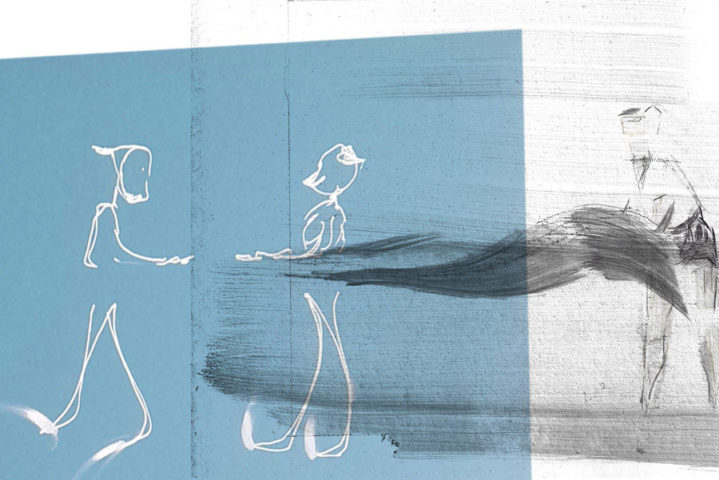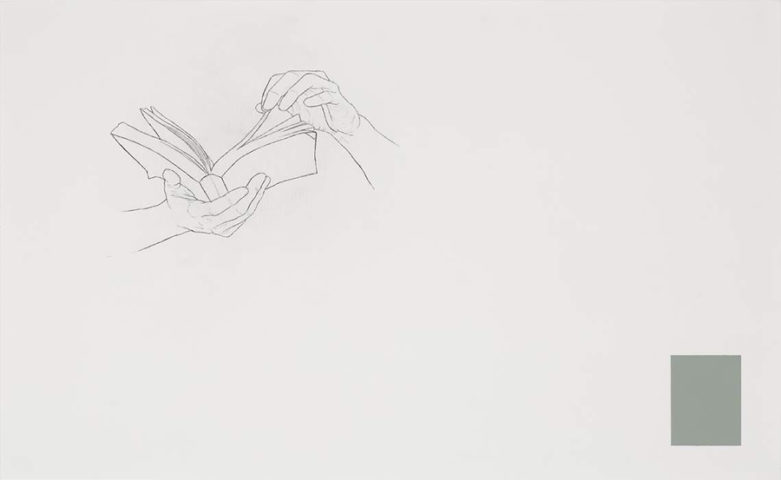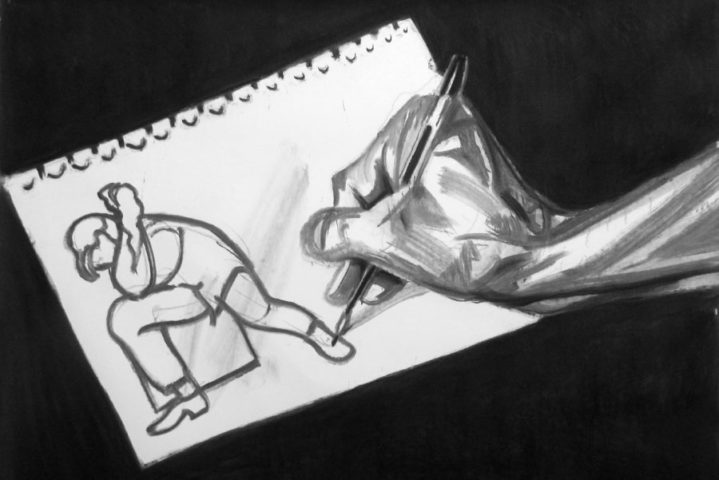On May 26, we will open Hole In The Ground, a collective exhibition that brings together works by Cabrita, Camila Cañeque, Hannah Collins, Pablo del Pozo, Mercedes Pimiento and Fernando Prats.
The title of the exhibition, inspired by a David Bowie song, refers to the main theme around the displayed pieces, the concept of territory and its materiality. Some of the works deal with the ways of representing the ground, understood as horizontality, both in nature and in the urban environment. In this way, human activity is put in the spotlight, evidencing aspects such as belonging to a territory, the memory of a place or exploitation of the soil and its impact.
While some of the presented works speak of very specific places, others refer to the material that we step on when walking. Cabrita, in his work Fingerprints, raises a horizontal plane to the wall, thus turning a simple board, a humble material that was surely used as a work surface in his studio, into a testimony of his artistic activity. The artist offers us a new look at an everyday object and also a review of the place of creation.
Camila Cañeque’s work ground on ground on ground shows accumulations of historical layers through grounds. The artist’s work addresses passivity and, in this installation, she uses the notion of the in-between, creating a space that is neither above nor below, before nor after.
Hannah Collins’ work Nomad places emphasis on the surface, on skin, on the outside, signaling the artist’s interest in boundaries – most specifically of the body. With this portrait of a character whose face remain hidden, the artist allows us to participate through the free interpretation of the image. The artist deals with the historical, the social and the political through images of everyday scene, such as Floor of dreams. This work, made in La Mina, is part of an extensive project by the artist focused on this neighbourhood inhabited mainly by the gypsy community in Barcelona.
In the work of Pablo del Pozo, interest in the territory is a recurring theme. In Tierra rojiza, the artist uses the pig as a symbol of his region of origin, to create a materiality that refers to the stereotyped vision of Extremadura as an arid and dry landscape.
Mercedes Pimiento’s work is characterized by making visible all the material culture that nourishes our society but which we try to hide, turning into sculptures the structures that are hidden in architecture, such as pipes, cables and canals, using organic or artificial materials.
Fernando Prats is interested in the territory of Chile and South America and its representation through historical or reinterpreted maps. In Territorio silenciado #2, he proposes a critical view of a continent condemned to be endlessly exploited. In Affatus, on the other hand, the canvas becomes the territory of creation where, subverting the traditional gesture of the painter, the worms have left their own mark. We also present an unreleased video, Zonificación, accompanied by a work on paper, composed from the projection of the recorded action, and which establishes a dialogue with the spiral staircase of the Macba, in a centrifugal movement that is access, exit, ascend and descend, the body and the architecture in connection and amplification with the Richard Meier building.
Cabrita (Lisbon, 1956) lives and works in Lisbon. His work has received international recognition and has been crucial to the understanding of sculpture since the mid-eighties. In recent years he has had solo exhibitions at CAC Malaga, Mudam Luxembourg, CGAC Santiago de Compostela, Museo Serralves Porto, Palazzo Molina de Cartagena, Mexico, Palazzo Fortuny, Venice, Galeria Arte Moderna e Contemporânea, Lisbon, MAXXI Rome, The Arts Club of Chicago and Hôtel des Arts, Toulon, France. He has participated in important international exhibitions, such as Documenta IX in Kassel (1992), the 21st and 24th São Paulo Biennial (1994 and 1998), the Venice Biennial (in 1997, in 2003 representing Portugal and in 2013) and the 10th Lyon Biennial (2009). He is currently showing the sculptural installation Les Trois Grâces, at Jardin des Tuileries, Paris, and an installation entitled Field at the 59th Venice Biennale.
Camila Cañeque (Barcelona, 1984) explores in different ways the theme of resistance to progress through performance, sound, objects, installations and writing. She has exhibited in several art centres in Barcelona such as La Virreina Centre de la Imatge, Blue Project Foundation, Fabra i Coats, Caixaforum, Museo Lázaro Galdiano, in Madrid and at the Queens Museum of Art, New York. She was a finalist for the Miquel Casablancas Prize and participated in residencies at Mana Contemporary, New Jersey, Fabra i Coats, Barcelona, Nida Art Colony, Lithuania, ZKU, Berlin, Largo das Artes, Rio de Janeiro, among others.
Hannah Collins (London, 1956). Currently lives between London and Almeria. Between 1989 and 2010, she lived in Barcelona, exhibiting at Galeria Joan Prats since 1992. She was awarded a Fulbright Fellowship, was nominated for the 1993 Turner Prize, and received the 2015 SPECTRUM International Photography Prize, including exhibitions at Sprengel Museum in Hannover, Camden Art Centre in London and Baltic Centre in Newcastle. Among other museums and art centres, she has exhibited at SFMOMA, San Francisco; Centre Pompidou Paris; FRAC Bretagne; Fotomuseum Winterthur; Museo UNAL, Bogotá; Kunsthalle Exnergasse, Vienna; MUDAM Luxembourg; Tate Modern, London; Seoul Museum of Art; VOX image contemporaine, Montreal; Walker Art Center, Minneapolis; Fundación La Caixa, Madrid and Barcelona; La Laboral, Gijón; Artium, Vitoria; CAC, Málaga.
Pablo del Pozo (Badajoz, 1994) lives and works in Barcelona. Graduated in Fine Arts at the Universitat de Barcelona, he was selected in the Biennial of Valls and has won the Guasch-Coranty Award, participating in the exhibition at the Centre Tecla Sala, in l’Hospitalet de Llobregat. He also participated in the Biennial Jeune Création Européenne with exhibitions in museums in various European cities. He has received the creation award of the Sala d’Art Jove de la Generalitat de Catalunya, exhibiting there in 2018. He was nominated for the Miquel Casablancas Prize, and in 2019 he exhibited individually at the Arranz Bravo Foundation in l’Hospitalet de Llobregat.
Mercedes Pimiento (Seville, 1990) lives and works in Barcelona, where she is pursuing a doctorate in Fine Arts. With a degree in Fine Arts from the Universidad de Sevilla and a Master’s Degree in Artistic Production and Research from the Universitat de Barcelona, she has been selected for programs and grants such as INJUVE, the Madrid Community Training Program – Open Studio, the Kiosko Project of the José Guerrero Centre, the Guasch Coranty Foundation Grant for artistic creation, the Sant Andreu Contemporani residency program, or the Iniciarte Program. She has exhibited in museums and art centres such as Centre Tecla Sala in L’Hospitalet de Llobregat, CAAC Seville, Fabra i Coats in Barcelona, Museo de Arte Contemporáneo Fundación Naturgy in A Coruña, Centro José Guerrero in Granada, among others.
Fernando Prats (Santiago de Chile, 1967) has lived and worked in Barcelona since 1990. His work is known for the actions undertaken mostly in Chile, among them Gran Sur, Isla Elefante, Antarctica, Acción Lota, Géiser del Tatio, Salar de Atacama, Mina a Rajo Abierto o Congelación, Collins Glacier and Chilean Antarctica. He has participated in exhibitions such as the Venice Biennale; Mediations Biennale, Poznan; Biennial of the Canary Islands, Chile Triennial, Espace Culturel Louis Vuitton, Paris, Fundació Joan Miró, Barcelona and Museo Nacional de Bellas Artes, Santiago de Chile. He has significant works in the public space of Chile and a work commissioned by Barcelona. He is currently presenting the solo exhibition Aun tendría que haber luciérnagas, at Fragmentos, Espacio de Arte y Memoria, Museo Nacional de Bogotá.



